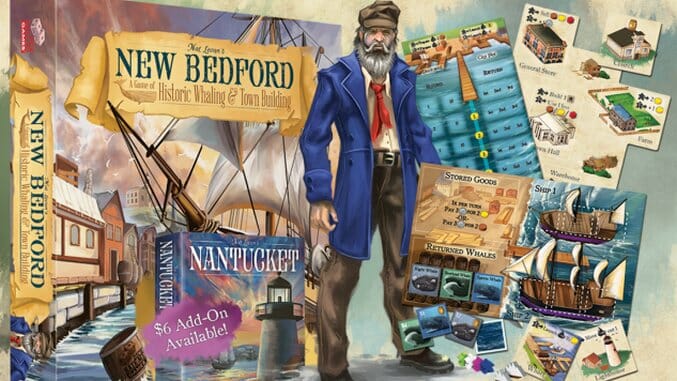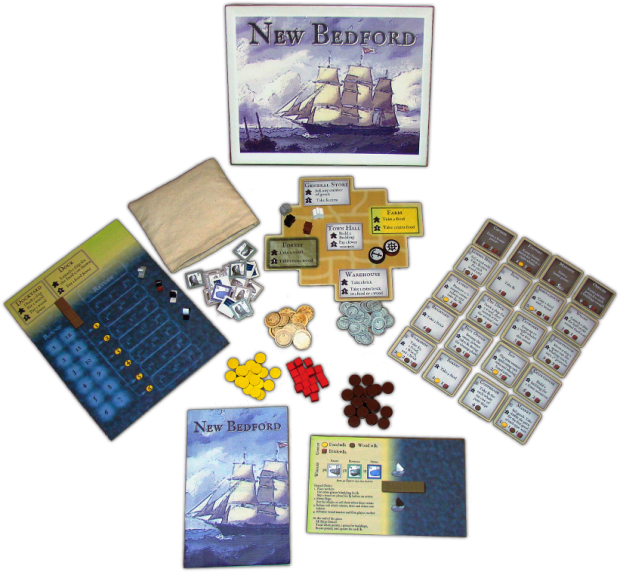
New Bedford, named for the Massachusetts town of that name, takes whaling as its theme. It creates a small narrative around the need to build and launch ships to catch whales, so players don’t just accumulate points for points’ sake, but spend most of the game doing things that garner points and help their whaling expeditions. The game manages to take the worker-placement mechanic and town-building theme found in more complex games like Caylus or Le Havre and simplify it enough that younger players can catch on to it. An entire game of twelve rounds runs well under an hour. It’s often a backhanded compliment—or subtle insult—to call a strategy boardgame “cute,” but New Bedford absolutely is that, between the artwork and the emphasis on a theme that plays small.
Set in the mid-1800s when New Bedford was booming, becoming one of the most important whaling ports in the world, this game starts out very simple, giving players just a few options for worker placement in the early turns until the town is built out by the players. Each player has only two meeples, and will place them each round, immediately taking the action from each space. The core town board has five options, where players can gather the game’s three resources (food and wood, required to launch whaling ships, and brick), build new buildings that get added to the town, or sell resources back for cash. There’s a second whaling board that has one space for players to build ships and another to launch them. These five spaces can be used by multiple players per round, but there’s a bonus for the player to choose each space first.
The two main paths to points in the game are through whaling ships and buildings. I don’t think it’s quite possible to ignore either of them and still compete, although it’s not necessary to balance the two. The base game comes with 20 buildings for players to construct with various combinations of brick, food and wood. Most of them create new action spaces—gaining $5 from the Bank, or 4 bricks from the Brickyard, or, what I think is the most valuable one, the Dry Dock, which allows players to build a ship and launch it in one fell swoop. Four of the buildings provide victory point bonuses at game-end, much as you’d find in Puerto Rico or the two games I mentioned above.
The town board has an irregular shape so that there are four edges to it where each player places the buildings s/he has built. Any player can use one of your buildings by paying you $1, after which no one can use it for the rest of the round. Regular buildings are worth a point apiece at game end, but the steady income you get from the buildings can prove critical.
Whaling ships require a lot of resource management, and the mechanic is the clear heart of New Bedford. You build a ship for just one or two wood tokens, but you launch it with food (the provisions for the crew). The more food you supply, up to six tokens, the farther from shore the ship goes, which confers two benefits on you: the farthest ship gets first claim on the whale tokens drawn from the bag in that round, and each ship stays out at sea for as many rounds as its provisions permit (equal to the number of food tokens).
The whale tokens are drawn each round from a bag that contains four token types: sperm whales, the rarest and most valuable (one per player); broad whales; right whales; and empty sea tokens. In a round, one whale token is drawn per ship at sea, plus one more; each player with a ship out chooses which whale token to take, from the ship farthest from shore to the nearest; any unclaimed tokens are returned to the bag. Thus as the game progresses the odds of drawing empty sea tokens increases, so getting a ship out early is useful.
When your ship comes in, however, you have to pay the “lay” on your whales, from $2 per right whale to $8 if you get lucky and land a sperm whale. You can sell a whale rather than keep it for points, taking half the lay as your return, after which other players get the chance to buy the whale from the market for the full cost. You get two ships, with no limit on how many whales each ship can hold, so getting lucky in the whale token draws can become very expensive, with only a few ways to get quick cash in the game.
Where New Bedford really nails the strategy balance is by keeping the number of meeples down without preventing players from doing what they need to do over the course of twelve rounds. There’s an economy (no pun intended) to the game that streamlines gameplay without feeling constricted; you get to build, as everyone builds your options increase, and as long as you keep a ship out there you’re involved in the whaling phase (and getting something) every round.
There’s an expansion coming as well called New Bedford: Rising Tide that allows for a fifth player, adds another 28 building tiles, and includes a Ship’s Log expansion of cards. The new buildings—five of which are for the 5-player game and three of which are for the Ship’s Log expansion—give you the Dominion-like power to customize the starting set of tiles for each game, without changing any of the base game’s mechanics or adding complexity to the rules, something that the additional cards end up doing.
New Bedford’s designer, Net Levan, also created a portable two-player game based loosely on the game Coin Age called Nantucket. The entire game of Nantucket comprises a few cards to represent the town, with six buildings per face; copper and silver coins; and one tiny captain token for each player. The coins fill in for resources and whale tokens too; to launch a ship, you stack up to four coins, and then shake them in your hand and toss them on the table, with the type of whale you catch derived from what combination of coins and of heads or tails you get. The game starts with three buildings available to both players, who can then build any of six other action buildings and three victory points buildings, with a couple of cards included to change up the buildings in each game. It’s a much shorter game than New Bedford, a trifle in comparison, more of a quick filler than a true spinoff.
I adore New Bedford’s theme and its clever implementation of a general mechanic that tends to lead toward longer, more complex games, and even without the expansion, the limit of twelve rounds (24 turns) per game means that even with four players you’re not going to get to build all of the available buildings, giving the base game real replay value. It’s one of the best introductions to worker placement games I’ve come across, easy for my ten-year-old daughter to understand during her first game, and we haven’t had a game run as long as 45 minutes yet. The game is best with three or more players since that creates real competition on the whaling track and depletes the bag of whale tiles more quickly, although with two players it’s still a fun game, just without that directly competitive aspect. This is a quiet gem, even if you have to tell your daughter that you’re not killing the whales, you’re just sending them to a giant farm upstate where they can swim around and play all day long.
Keith Law is a senior baseball writer for ESPN.com and an analyst on ESPN’s Baseball Tonight. You can read his baseball content at search.espn.go.com/keith-law and his personal blog the dish, covering games, literature, and more, at meadowparty.com/blog.
